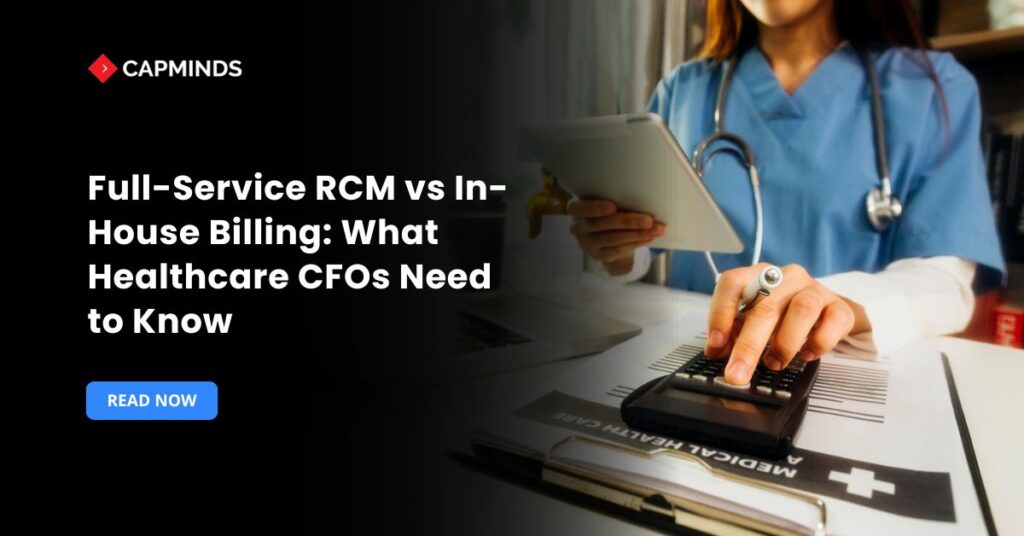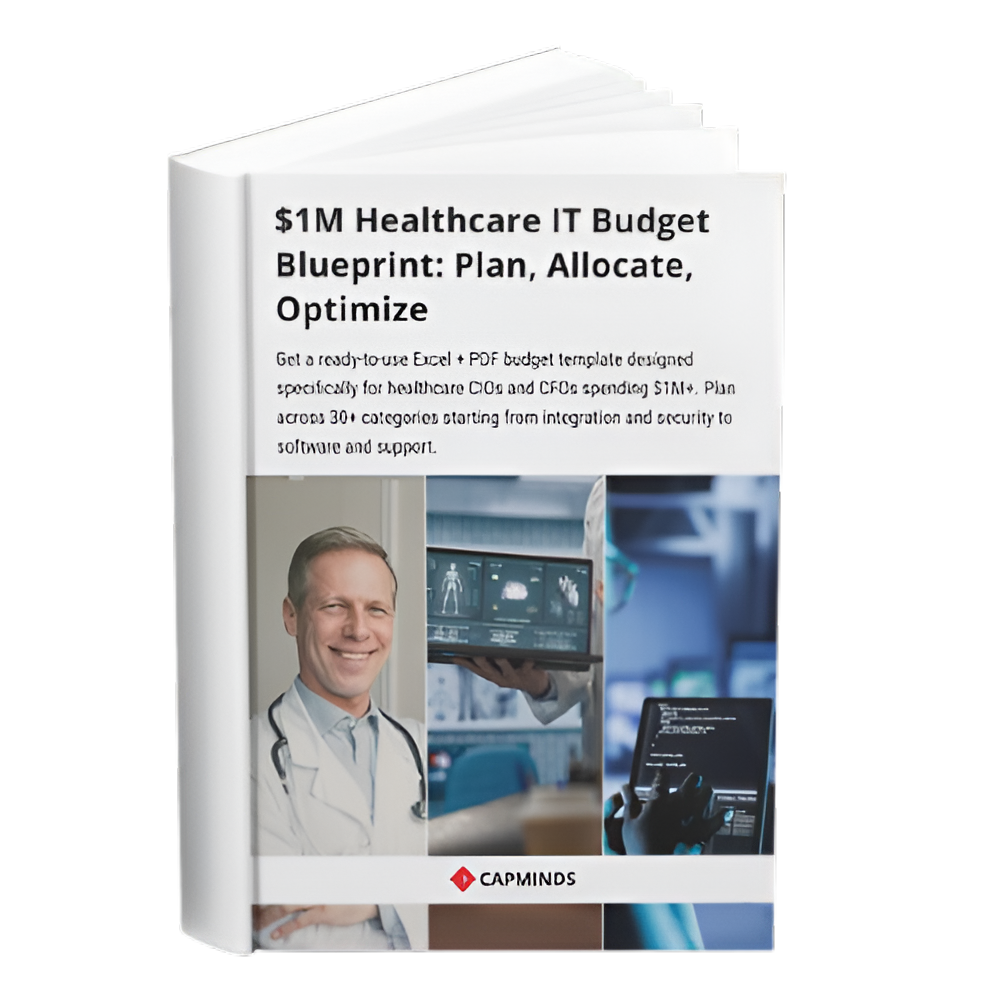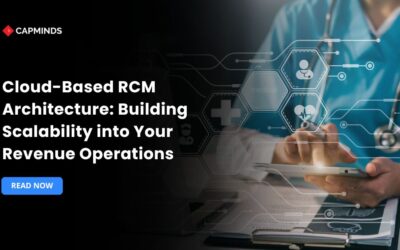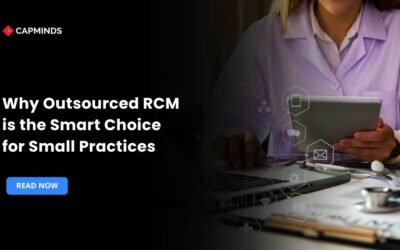Full-Service RCM vs In-House Billing: What Healthcare CFOs Need to Know
Healthcare organizations manage patient billing either in-house or via full-service RCM partners. Full-service RCM companies handle the entire revenue cycle, from patient registration and coding to claims submission, follow-up, and collections, on behalf of the provider. In contrast, in-house billing means the provider’s own employees perform all billing tasks, maintaining direct control and oversight.
The U.S. RCM market is huge and growing; for example, one report notes ~32–61% of providers are turning to outsourcing. As RCM becomes more complex, choosing between these models involves weighing trade-offs in cost, efficiency, scalability, compliance, and technology.
Full-Service RCM vs In-House Billing Comparison
1. Cost and Efficiency
Cost Models: In-house billing carries significant fixed overhead, salaries, benefits, training, office space, software, and hardware. A well-run practice may need roughly 2.7 billing staff per physician. By contrast, outsourcing shifts many fixed costs to a variable service fee. Most RCM vendors charge a percentage of collections or flat fees. Outsourced billing costs about 5.4% of collections versus roughly 13.7% in-house. Practices can cut billing expenses by ~30% through outsourcing.
In real terms, poor in-house billing can be very expensive: one industry analysis estimates U.S. doctors lose ~$125 billion annually to poor billing practices, and “80% of medical bills contain errors” that cost the industry over $100 billion per year.
Operational Efficiency: Outsourced RCM services invest in expertise and automation, often achieving higher accuracy and faster cash flow. For instance, one study reported an 80% first-pass claim payment rate under outsourced billing vs only 68% in-house, and 88% of payments collected within 30 days. This means outsourced teams submit more “clean” claims and resolve denials quickly.
Some specialized firms even achieve ~95% clean-claim rates on first submissions. In-house billing, by contrast, can be slower and error-prone. Manual processes and staffing gaps lead to more denials and longer collection cycles:
Industry data show 77% of providers take over a month to collect payment, and only about 72% of claims are paid within 30 days under in-house models. Even small error rates add up: one analysis found the average claim has a ~7–10% error rate, and these mistakes trigger rework that slows billing.
| Factor | Full-Service RCM (Outsourced) | In-House Billing |
| Cost | Variable fees (often ~5–10% of collections); fewer full-time payroll costs. Vendor shoulders software/upgrades. | High fixed overhead (salaries, benefits, training, software). MGMA data: in-house billing ~13.7% cost to collect a dollar. |
| Staffing | Access to a full team of certified coders and billers; vendor handles turnover and training. | Must recruit/retain billing staff (e.g., ~2.7 billers per MD), subject to staff shortages and turnover. |
| Efficiency | Standardized workflows and automation yield higher accuracy and faster payments (e.g., 80% vs 68% first-pass claims). | Dependent on internal expertise, more manual entry can mean lower clean-claim rates and slower collections. |
| Denials & Errors | Proactive denial management teams aim to reduce errors (clean claim targets ~90%+). | Higher denials from manual mistakes (nationally, 80% of bills have errors), and each denial delays cash. |
| Scalability | Easily scale volumes up/down by reallocating vendor resources. No hiring needed for growth. | Scaling requires hiring/training new staff or paying overtime; limited by physical office space and personnel. |
| Technology | Cutting-edge RCM platforms (AI, predictive analytics, dashboards) are provided by the vendor. | May use outdated or basic software; upgrades and security are internal expenses. |
| Control & Communication | Less direct oversight; must coordinate with the vendor for updates or investigations. Possible communication lags. | Full control of processes; instant access to billing data. Changes or policy updates can be implemented immediately. |
| Compliance | Vendor experts stay current on coding and regs (HIPAA, payer rules) and assume much audit risk. | Responsibility remains entirely with the provider: must train staff on regs and risk fines for errors. |
| Patient Experience | Often provide patient payment portals and explainers, but with less personal touch on billing issues. | Direct provider-managed patient contact for billing inquiries; may offer more familiar service. |
2. Scalability and Flexibility
One often-cited advantage of outsourcing is scalability. Full-service RCM vendors can adjust staffing and resources up or down as patient volumes change. For example, during seasonal peaks or sudden growth, an outsourced partner can deploy more billers and tech support seamlessly, whereas an in-house department would need to hire or reassign staff (a slow, costly process). A market survey found 61% of providers are planning to use third-party RCM, reflecting this demand for flexibility.
That said, scalability is not automatic. Vendors also face industry-wide staffing crunches. A recent report noted that many RCM firms struggle to onboard qualified billers quickly during labor shortages. In contrast, an in-house team might have stability (fewer turnover cycles), but true scaling (e.g., for a clinic expanding multiple new sites) is harder without new hires. Ultimately, outsourcing offers built-in elasticity at the expense of sharing control, while in-house operations have rigid capacity tied to payroll.
3. Compliance and Technology
Staying compliant with complex regulations (HIPAA, ICD updates, audits, No Surprises Act, etc.) is a huge burden. Outsourced RCM vendors typically employ dedicated compliance teams and invest in software to enforce rules. They promise that keeping up with coding changes and payer policies is “their job,” potentially reducing audit risk for providers. Indeed, RCM vendors claim to shift some audit liability to themselves by contractual obligation.
In-house teams, by contrast, must absorb all compliance tasks. This requires continuous training and oversight. Smaller organizations may struggle to fund experts for each new rule. A high-profile example shows the risk: when Change Healthcare (a major outsourced RCM provider) was hit by a cyberattack in 2024, affected providers saw months of billing disruptions. Even though patient data was compromised at the vendor level, physicians still bore the brunt, 80% lost revenue on unpaid claims, and 77% reported care delays. This underscores that outsourcing can introduce third-party risk (data security, vendor downtime), which in-house billing might avoid (at the cost of internal security investment).
On technology, outsourced RCM often leads with advanced tools. Many firms now use AI-driven claim scrubbers, predictive denial analytics, and real-time dashboards. For example, Athelas (an RCM AI firm) boasts an 81% first-pass approval rate and collects ~94% of revenues owed. In-house operations typically lack such cutting-edge infrastructure unless the organization has deep IT resources. According to one industry report, up to 75% of providers still rely on paper or manual collection processes. Outsourcing can therefore bring modern tech “as a service,” while in-house teams must budget for their own upgrades.
Related: A Complete Front-End RCM Workflow: From Patient Intake to Claim Submission
Real-World RCM Challenges Faced By Healthcare CFOs
Regardless of model, U.S. healthcare leaders face common revenue-cycle pressures. Staffing shortages are acute: Experian’s 2025 survey found 43% of providers report being understaffed in revenue cycle roles. Fewer coders and billers means more work left undone, whether in-house or outsourced (vendors feel the pinch too). Rising denial rates also plague practices.
Experts found 41% of providers now face denial rates ≥10%, and in one benchmark, 38% of respondents said 10% of their claims are denied on first submission. Each denial must be corrected (often manually), straining teams. Staffing shortfalls directly worsen this, as fewer experts chase denials and appeals.
Regulatory burden is another drag. Frequent coding changes, complicated multi-payer rules, and new patient-financial laws all create work. One industry executive lamented that claims errors and frequent policy changes are “adding immense pressure” on RCM. Smaller clinics especially cite staying current as overwhelming. Aging receivables amplify these issues: claims that remain 90–120+ days outstanding are very unlikely to be paid. In fact, experts note that healthcare often collects only 10 cents on the dollar for claims after 120 days. This means delayed billing quickly erodes revenue.
These challenges affect both models. However, they underscore why many leaders seek robust solutions: high denial rates and aging AR can be mitigated by cleaner claims and aggressive follow-up.
Pros and Cons at a Glance
| Aspect | Full-Service RCM (Outsourced) | In-House Billing |
| Pros | Low overhead (no billing payroll); built-in expertise and tech, flexible scaling; vendor assumes much of compliance work. Often faster payments (e.g., higher first-pass rates). | Full control of processes; immediate oversight and customization; direct integration with clinical staff. No reliance on external vendors for critical data. |
| Cons | Less direct control/visibility; potential communication delays; vendor lock-in and dependency. Risk of data breaches or service outages beyond your control. May incur unexpected fees. | High fixed costs. Hard to recruit/retain billing staff amid industry shortages. Likely slower, more errors without continuous investment in training and tech. |
Related: What to Look for in an RCM Platform: A Buyer’s Guide for 2025
Choosing the Right Model
There is no one-size-fits-all answer. Organizational size and needs are key. Large health systems and hospitals often have the volume and resources to justify a full in-house department. They can maintain specialized teams and custom processes, potentially achieving tight integration and control. In contrast, small to mid-sized practices typically lack deep billing staff and benefit most from outsourcing. Outsourcing can give them instant access to coders, technology, and economies of scale they couldn’t afford internally.
Decision-makers should assess factors such as patient volume, payer mix complexity, and growth plans. High-volume specialties with complex procedures may lean toward outsourcing or hybrid models, whereas straightforward practices might stay in-house.
Evaluate your current performance metrics, e.g., billing cost per claim, denial rate, days in AR, and project how each model could improve them. Cost analysis is critical: compare your total in-house expense against vendor fee models. Also consider strategic goals: if focusing on patient care and agility is a priority, outsourcing “lifts” administrative burdens.
Finally, remember that a hybrid approach is possible. Some organizations keep eligibility verification or coding in-house, but outsource A/R follow-up or denial appeals. Others begin with one service and expand.
Transform Your Revenue Cycle with CapMinds RCM Services
At CapMinds, we understand that navigating claim denials, compliance, cybersecurity, and staffing shortages is overwhelming for healthcare organizations. That’s why we deliver end-to-end RCM services designed to secure your financial health and reduce administrative burden.
Our RCM medical billing services combine expert billing teams with cutting-edge technology to help you achieve a faster, cleaner, and more resilient revenue cycle.
With CapMinds, you can:
- Optimize RCM workflows through AI-driven claim scrubbing and denial management.
- Boost collections with patient-centric billing and multiple payment options.
- Stay compliant with evolving payer rules and federal regulations.
- Strengthen security through advanced data protection frameworks.
- Scale effortlessly by outsourcing RCM services to our dedicated specialists.
Partner with CapMinds to turn your RCM challenges into opportunities.
Let us streamline your billing, protect your revenue, and empower your staff to focus on what matters most: delivering exceptional patient care.




